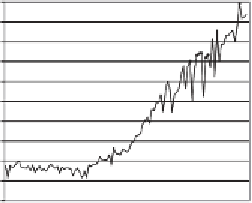Agriculture Reference
In-Depth Information
size to increased resistance to Fusarium head
blight. Likewise Cox et al. (1988) attributed the
increase in kernel weight in their study to
increased resistance to stem rust and leaf rust. In
three cases (Waddington et al., 1986; Slafer and
Andrade 1993; Guarda et al., 2004), kernel weight
had been reduced, indicating that breeders must
actively select for kernel size. Three studies
revealed an increase in grain volume weight, a
trait that had been selected for by the respective
breeding program (Cox et al., 1988; Sayre et al.,
1997; Underdahl et al., 2008).
Although genetic variability for aboveground
biomass may exist, often changes in grain yield
are not accompanied by changes in biomass when
comparing old cultivars with new cultivars.
However, when comparing among only contem-
porary cultivars, parallel increases in grain yield
and biomass may be found (Table 17.2). This is
important since several authors have suggested
that future yield advances will likely derive from
increases in biomass (Austin 1999; Reynolds
et al., 1999; Fischer 2007; Foulkes et al., 2007).
They speculated that since so much progress to
date has been made from increasing HI, breeders
should turn their attention to increasing biomass.
Fischer (2007) pointed out that further gains in
HI are possible since most wheat cultivars have a
HI of about 45% and the purported upper limit
to HI is 60% (Austin 1980).
The physiological basis of genetic improve-
ment in wheat has been reviewed extensively,
such as Fischer (2007), Reynolds et al. (1999), and
Foulkes et al. (2007). Increased HI is associated
with altered partitioning to the spike that in turn
leads to more kernels through more fertile fl orets
and reduced kernel abortion. Shearman et al.
(2005) showed genetic gain in preanthesis radia-
tion-use effi ciency and water-soluble carbohy-
drate content at anthesis. They concluded that
genetic gain for grain yield in UK wheat cultivars
was both sink- and source-related. An improved
growth rate before anthesis led to an increase in
the number of grains per meter squared (sink),
and the increase in stem soluble carbohydrate
reserves provided a larger source for grain fi lling.
Slafer and Andrade (1993) found that in some
new cultivars spike development occurred earlier
and thus were more competitive for photosyn-
thate. Many researchers agree that even with the
increased kernel number in new cultivars, wheat
is still sink-limited (Fischer 2007; Foulkes et al.,
2007; Reynolds 2007).
WHEAT YIELD GAINS IN LIGHT OF
OTHER CROPS
Wheat yield in the UK has reached an unprece-
dented level of 7,700 kg ha
−1
, with Germany and
France not far behind (Table 17.1). This level is
comparable to maize yields in the US only 10
years ago (Fig. 17.2). Wheat production in the
UK is intensively managed. Standard manage-
ment practices include 200 kg ha
−1
nitrogen fertil-
izer, two applications of foliar fungicides, and the
application of a plant growth regulator. The
breeding programs have obviously been success-
ful developing cultivars for this system. Shear-
man et al. (2005) found that contemporary
cultivars in the UK had higher HI and produced
more biomass and more spikes per unit area than
the cultivars they replaced. Most cultivars in their
study were considered feed-grade wheat; thus the
observed genetic gain could have exceeded the
level which might be expected with the added
complexity of multiple selection criteria for
improved breadmaking performance.
China produces more wheat than any other
country in the world (Table 17.1). The gain in
10,000
9,000
8,000
7,000
Maize
6,000
Wheat
Soybean
5,000
4,000
3,000
2,000
1,000
0
Fig. 17.2
Maize, wheat, and soybean yields in the US from
1900 to 2007. Data assembled from USDA Agricultural Sta-
tistical Service online resources (http://www.nass.usda.gov/).














